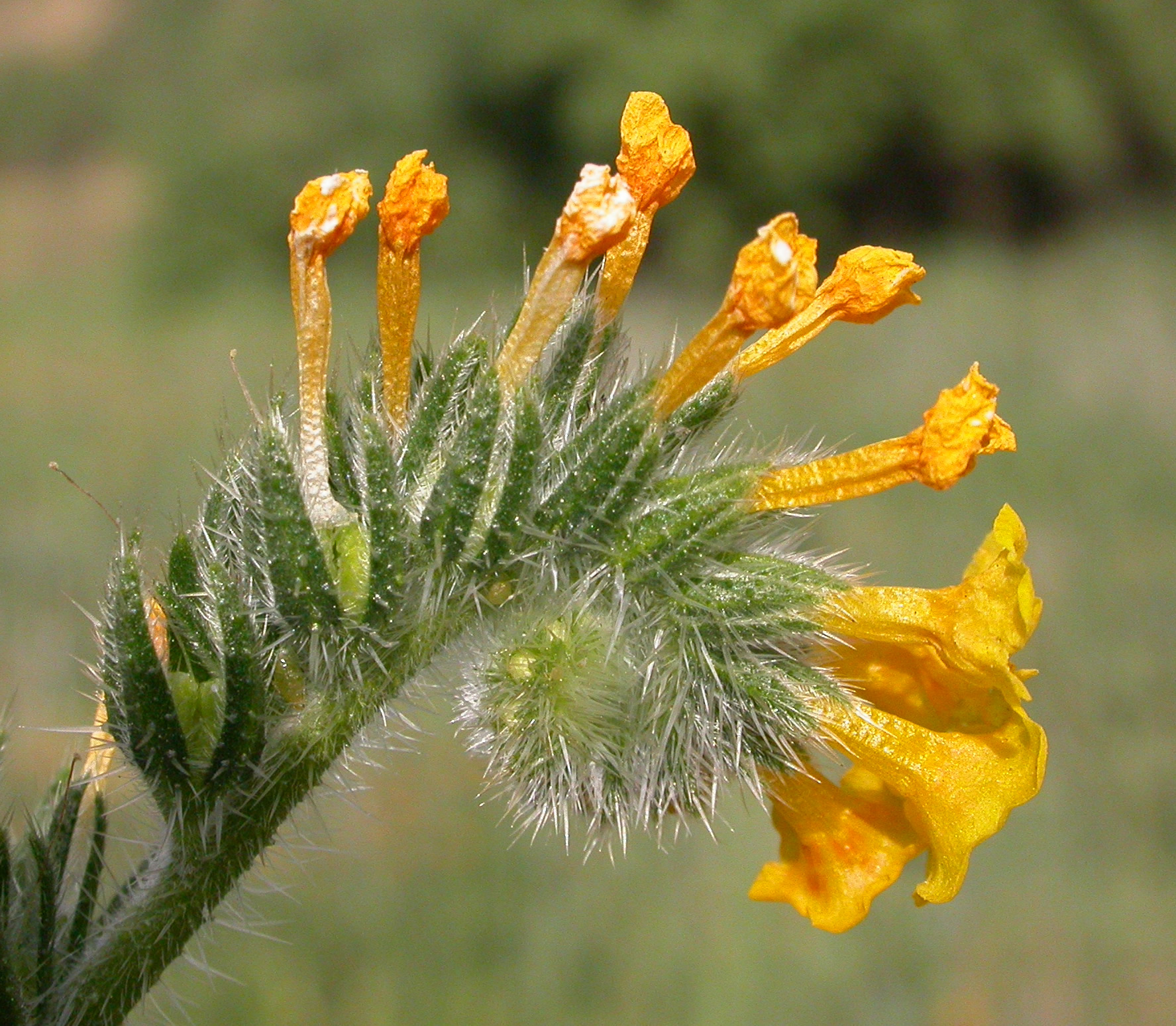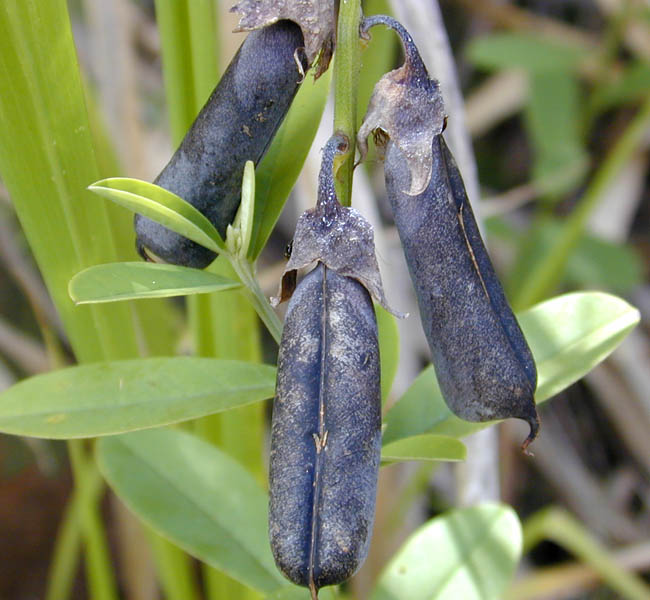|
Pyrrolizidine Alkaloid
Pyrrolizidine alkaloids (PAs), sometimes referred to as necine bases, are a group of naturally occurring alkaloids based on the structure of pyrrolizidine. Pyrrolizidine alkaloids are produced by plants as a defense mechanism against insect herbivores. More than 660 PAs and PA N-oxides have been identified in over 6,000 plants, and about half of them exhibit hepatotoxicity. They are found frequently in plants in the Boraginaceae, Asteraceae, Orchidaceae and Fabaceae families; less frequently in the Convolvulaceae and Poaceae, and in at least one species in the Lamiaceae. It has been estimated that 3% of the world’s flowering plants contain pyrrolizidine alkaloids. Honey can contain pyrrolizidine alkaloids, as can grains, milk, offal and eggs. To date (2011), there is no international regulation of PAs in food, unlike those for herbs and medicines. Unsaturated pyrrolizidine alkaloids are hepatotoxic, that is, damaging to the liver. PAs also cause hepatic veno-occlusive d ... [...More Info...] [...Related Items...] OR: [Wikipedia] [Google] [Baidu] |
Pyrrolizidine Alkaloidosis
Pyrrolizidine alkaloidosis is a disease caused by chronic poisoning found in humans and other animals caused by ingesting poisonous plants which contain the natural chemical compounds known as pyrrolizidine alkaloids.''The Merck Veterinary Manual''. Pyrrolizidine Alkaloidosis: Introduction (Seneciosis, Senecio poisoning, Ragwort toxicity). Merck & Co., Inc., 2008. Web. 15 November Pyrrolizidine alkaloidosis can result in damage to the liver, kidneys, heart, brain, smooth muscles, lungs, DNA, lesions all over the body, and could be a potential cause of cancer.Rizk, Abdel-Fattah M., ''Naturally Occurring Pyrrolizidine Alkaloids''. Doah: CRC Press, 1990 Pyrrolizidine alkaloidosis is known by many other names such as "Pictou Disease" in Canada and "Winton Disease" in New Zealand.Hirono, I. ''Naturally Occurring Carcinogens of Plant Origin''. Toyoake: Elsevier, 1987 Cereal crops and forage crops can sometimes become polluted with pyrrolizidine-containing seeds, resulting in the ... [...More Info...] [...Related Items...] OR: [Wikipedia] [Google] [Baidu] |
Retronecine
Retronecine is a pyrrolizidine alkaloid found in a variety of plants in the genera ''Senecio'' and ''Crotalaria'', and the family Boraginaceae Boraginaceae, the borage or forget-me-not family, includes about 2,000 species of shrubs, trees and herbs in 146, to 156 genera with a worldwide distribution. The APG IV system from 2016 classifies the Boraginaceae as single family of the .... It is the most common central core for other pyrrolizidine alkaloids. References Pyrrolizidine alkaloids {{alkaloid-stub ... [...More Info...] [...Related Items...] OR: [Wikipedia] [Google] [Baidu] |
Cancer Research (journal)
''Cancer Research'' is a biweekly peer-reviewed medical journal published by the American Association for Cancer Research. It covers research on all aspects of cancer and cancer-related biomedical sciences and was established in 1941. The editor-in-chief is Chi Van Dang. The journal was established in 1916 as the ''Journal of Cancer Research'', was renamed ''American Journal of Cancer'' in 1931, and obtained its current name in 1941. Abstracting and indexing The journal is abstracted and indexed in: According to the ''Journal Citation Reports'', the journal has a 2020 impact factor The impact factor (IF) or journal impact factor (JIF) of an academic journal is a scientometric index calculated by Clarivate that reflects the yearly mean number of citations of articles published in the last two years in a given journal, as ... of 12.701. References External links * {{Official website, http://cancerres.aacrjournals.org Oncology journals Publications established in 1916 ... [...More Info...] [...Related Items...] OR: [Wikipedia] [Google] [Baidu] |
Greta Oto
''Greta oto'' is a species of brush-footed butterfly and member of the subfamily Danainae, tribe Ithomiini, and subtribe Godyridina. It is known by the common name glasswing butterfly for its transparent wings, which allow it to camouflage without extensive coloration. In Spanish speaking regions, it may also be referred to as ''espejitos'', meaning "little mirrors" because of its transparent wings. The butterfly is mainly found in Central and northern regions of South America with sightings as far north as Texas and as far south as Chile. While its wings appear delicate, the butterfly is able to carry up to 40 times its own weight.Lamas, G. (Ed.). (2004). ''Checklist: Part 4A. Hesperioidea - Papilionoidea.'' ''In'': Heppner, J. B. (Ed.), ''Atlas of Neotropical Lepidoptera. Volume 5A.'' Gainesville, Association for Tropical Lepidoptera; Scientific Publishers. In addition to its wing physiology, the butterfly is known for behaviors such as long migrations and lekking. ''Greta oto ... [...More Info...] [...Related Items...] OR: [Wikipedia] [Google] [Baidu] |
Danaus Chrysippus
''Danaus chrysippus'', also known as the plain tiger, African queen, or African monarch, is a medium-sized butterfly widespread in Asia, Australia and Africa. It belongs to the Danainae subfamily of the brush-footed butterfly family Nymphalidae. Danainae primarily consume plants in the genus ''Asclepias'', more commonly called milkweed. Milkweed contains toxic compounds, cardenolides, which are often consumed and stored by many butterflies. Because of their emetic properties, the plain tiger is unpalatable to most predators. As a result, its coloration is widely mimicked by other species of butterflies. The plain tiger inhabits a wide variety of habitats, although it is less likely to thrive in jungle-like conditions and is most often found in drier, wide-open areas. ''D. chrysippus'' encompasses three main subspecies: ''D. c. alcippus, D. c. chrysippus,'' and ''D. c. orientis.'' These subspecies are found concentrated in specific regions within the larger range of the entire sp ... [...More Info...] [...Related Items...] OR: [Wikipedia] [Google] [Baidu] |
Mating
In biology, mating is the pairing of either opposite- sex or hermaphroditic organisms for the purposes of sexual reproduction. ''Fertilization'' is the fusion of two gametes. ''Copulation'' is the union of the sex organs of two sexually reproducing animals for insemination and subsequent internal fertilization. Mating may also lead to external fertilization, as seen in amphibians, fishes and plants. For most species, mating is between two individuals of opposite sexes. However, for some hermaphroditic species, copulation is not required because the parent organism is capable of self-fertilization ( autogamy); for example, banana slugs. The term ''mating'' is also applied to related processes in bacteria, archaea and viruses. Mating in these cases involves the pairing of individuals, accompanied by the pairing of their homologous chromosomes and then exchange of genomic information leading to formation of recombinant progeny (see mating systems). Animals For animals, ... [...More Info...] [...Related Items...] OR: [Wikipedia] [Google] [Baidu] |
Pheromones
A pheromone () is a secreted or excreted chemical factor that triggers a social response in members of the same species. Pheromones are chemicals capable of acting like hormones outside the body of the secreting individual, to affect the behavior of the receiving individuals. There are ''alarm pheromones'', ''food trail pheromones'', ''sex pheromones'', and many others that affect behavior or physiology. Pheromones are used by many organisms, from basic unicellular prokaryotes to complex multicellular eukaryotes. Their use among insects has been particularly well documented. In addition, some vertebrates, plants and ciliates communicate by using pheromones. The ecological functions and evolution of pheromones are a major topic of research in the field of chemical ecology. Background The portmanteau word "pheromone" was coined by Peter Karlson and Martin Lüscher in 1959, based on the Greek φερω ''pheroo'' ('I carry') and ὁρμων ''hormon'' ('stimulating'). Pheromones ... [...More Info...] [...Related Items...] OR: [Wikipedia] [Google] [Baidu] |
Queen (butterfly)
The queen butterfly (''Danaus gilippus'') is a North and South American butterfly in the family Nymphalidae with a wingspan of . It is orange or brown with black wing borders and small white forewing spots on its dorsal wing surface, and reddish ventral wing surface fairly similar to the dorsal surface. The ventral hindwings have black veins and small white spots in a black border. The male has a black androconial scent patch on its dorsal hindwings. It can be found in meadows, fields, marshes, deserts, and at the edges of forests. This species is possibly a close relative to the similarly colored soldier butterfly (or tropical queen, '' D. eresimus''), in any case, it is not close to the plain tiger ('' D. chrysippus'', African queen) as was long believed. There are seven subspecies. Females lay one egg at a time on larval host plants. Larvae use these plants as a food source, whereas adult butterflies feed mainly on nectar from flowers. Unpalatability to avian predators is a f ... [...More Info...] [...Related Items...] OR: [Wikipedia] [Google] [Baidu] |
Utetheisa Ornatrix
''Utetheisa ornatrix'', also called the bella moth, ornate moth or rattlebox moth is a moth of the subfamily Arctiinae. It is aposematically colored ranging from pink, red, orange and yellow to white coloration with black markings arranged in varying patterns on its wings. It has a wingspan of 33–46 mm. Moths reside in temperate midwestern and eastern North America as well as throughout Mexico and other parts of Central America. Unlike most moths, the bella moth is diurnal. Formerly, the bella moth or beautiful utetheisa of temperate eastern North America was separated as ''Utetheisa bella''. Now it is united with the bella moth in ''Utetheisa ornatrix''. The larvae usually feed on ''Crotalaria'' species, which contain poisonous alkaloid compounds that render them unpalatable to most predators. Larvae may prey on other bella moth larvae in order to compensate for any alkaloid deficiency. The bella moth also demonstrates complex mating strategies and is thus an excellent ... [...More Info...] [...Related Items...] OR: [Wikipedia] [Google] [Baidu] |
Ruminant
Ruminants (suborder Ruminantia) are hoofed herbivorous grazing or browsing mammals that are able to acquire nutrients from plant-based food by fermenting it in a specialized stomach prior to digestion, principally through microbial actions. The process, which takes place in the front part of the digestive system and therefore is called foregut fermentation, typically requires the fermented ingesta (known as cud) to be regurgitated and chewed again. The process of rechewing the cud to further break down plant matter and stimulate digestion is called rumination. The word "ruminant" comes from the Latin ''ruminare'', which means "to chew over again". The roughly 200 species of ruminants include both domestic and wild species. Ruminating mammals include cattle, all domesticated and wild bovines, goats, sheep, giraffes, deer, gazelles, and antelopes.Fowler, M.E. (2010).Medicine and Surgery of Camelids, Ames, Iowa: Wiley-Blackwell. Chapter 1 General Biology and Evolution addresses th ... [...More Info...] [...Related Items...] OR: [Wikipedia] [Google] [Baidu] |
Chinese Herbology
Chinese herbology () is the theory of traditional Chinese herbal therapy, which accounts for the majority of treatments in traditional Chinese medicine (TCM). A ''Nature'' editorial described TCM as "fraught with pseudoscience", and said that the most obvious reason why it has not delivered many cures is that the majority of its treatments have no logical mechanism of action. The term herbology is misleading in the sense that, while plant elements are by far the most commonly used substances, animal, human, and mineral products are also utilized, among which some are poisonous. In the ''Huangdi Neijing'' they are referred to as () which means toxin, poison, or medicine. Paul U. Unschuld points out that this is similar etymology to the Greek '' pharmakon'' and so he uses the term "pharmaceutic". Thus, the term "medicinal" (instead of herb) is usually preferred as a translation for (). Research into the effectiveness of traditional Chinese herbal therapy is of poor quality an ... [...More Info...] [...Related Items...] OR: [Wikipedia] [Google] [Baidu] |
Tussilago
''Tussilago farfara'', commonly known as coltsfoot, is a plant in the tribe Senecioneae in the family Asteraceae, native to Europe and parts of western and central Asia. The name "tussilago" is derived from the Latin ''tussis'', meaning cough, and ''ago'', meaning to cast or to act on. It has had uses in traditional medicine, but the discovery of toxic pyrrolizidine alkaloids in the plant has resulted in liver health concerns. ''Tussilago farfara'' is the only accepted species in the genus ''Tussilago'', although more than two dozen other species have at one time or another been considered part of this group. Most of them are now regarded as members of other genera ''( Chaptalia, Chevreulia, Farfugium, Homogyne, Leibnitzia, Petasites, Senecio).''Flann, C (ed) 2009+ Global Composi ... [...More Info...] [...Related Items...] OR: [Wikipedia] [Google] [Baidu] |





.png)
